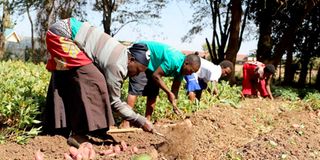Sweet potato the new cash cow for these herders

Sweet potato farmers harvest the produce in Maralal, Samburu County.
What you need to know:
- The sweet potato community farm has become the model for eight similar projects in Samburu County.
- The produce is harvested in portions to prevent flooding the market for better earnings.
On the outskirts of Maralal, the headquarters of Samburu County, dozens of farmers gather to harvest sweet potatoes.
It is a sight to behold. For some of them, this is the first time they are harvesting the crop, which was introduced in the arid area one-and-half years ago.
Peter Areman, a farmer, says they started growing the orange-fleshed sweet potatoes because the crop matures faster and is able to survive in the area that receives little rainfall and daytime temperatures sometimes hit 32o Celsius.
“This crop is changing our fortunes at a time pastoralism is facing threat from drought that leads to death of animals. We eat the potatoes and also sell them for cash,” says Areman, a member of Nyuat OFSP Community Group, which has about 100 farmers who collectively grow the crop on the two-acre farm.
The land is divided into small portions to enable them grow the crops at different times to harvest all the year round.
Before visiting the farm, Seeds of Gold team had toured the local livestock market. There, livestock keepers had brought hundreds of their visibly weak and malnourished animals for sale at throw away prices of Sh3,000.
The sweet potato community farm has become the model for eight similar projects in the county, with land under potatoes totalling 22 acres benefitting over 3,200 farmers.
Officers from the Kenya Agricultural and Livestock Research Organization (Kalro) provide them with expertise on how to plant the crop and planting materials at Sh5 each.

Peter Areman tends to sweet potato crop in Maralal, Samburu County.
John Shitsukane, an agricultural officer from Kalro, Kitale, says the potato variety grows well in dry environment areas if well-tended and matures quicker.
“It takes the crop about three months to mature as compared to four to six months for other varieties. This development is important because this is an area plagued with food shortage,” says Shitsukane.
The crop offers five tubers per plant, which makes it more profitable. Shitsukane guides the farmers in selecting vines of about 30cm each, which are first grown in a greenhouse before they are transplanted to the field.
“Getting good quality vines is a challenge but we are working harder as Kalro to supply planting materials that can resist pests and diseases,” says the officer, adding they get support from ChildFund.
The crop is irrigated using water drawn from a nearby borehole and stored in tanks. The produce is harvested in portions to prevent flooding the market for better earnings.
“This variety of sweet potato is rich in Vitamin A, which gives it its orange colour. It is good especially for mothers and school-going children,” says Isaac Kariuki, a project officer at ChildFund.
However, as farmers step up production of the crop, they have to contend with competition from produce from other regions, including Nyahururu, where traders source and sell their produce at Sh50 per kilo while the locals sell at Sh70.
“We are also not able to store the potatoes for a long time especially when we have no market. We hope to process the produce into a variety of products such as flour and pastries to increase earnings,” says Kariuki.
Nonetheless, he is hopeful of what the future holds as the sweet potato venture grows. The group is planning to extend their farm during the next planting season.





